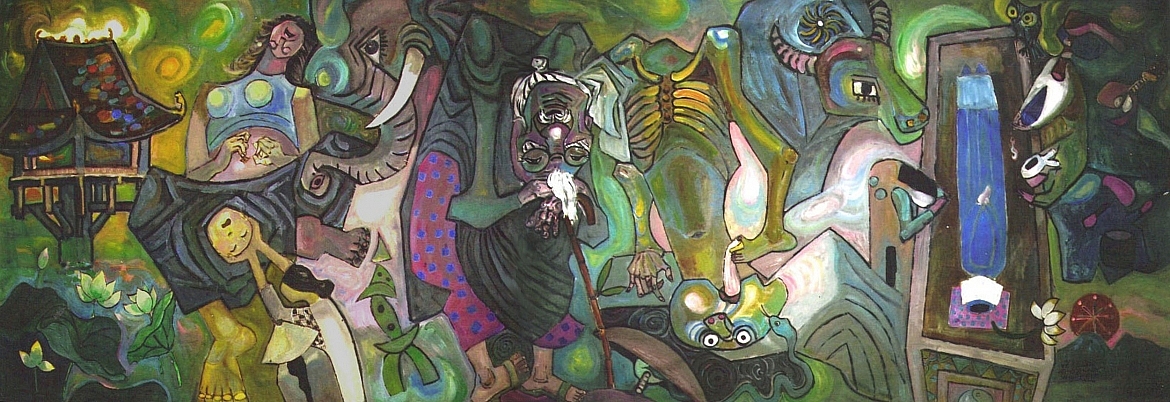
Upsidedownism paintings inspired by Buddhism art
23 September, 2017
(Mural: Born – Old – ill – Die)
The Phap Nguyen Pagoda in Pearland, Texas is fortunate to own most of the Buddhist paintings by artist DaiGiang Nguyen from 1997 to present.
Buddhist Paintings:
These paintings consist of 5 paintings of 6′ x 18′ murals depicting the Four Noble Truths including Suffering, Causes of Suffering, End of Suffering, the Way Leading to the End of Suffering, as well as a mural on the life of the bodhisattva Thi Kinh. The sixth mural is being planned for the fall of 2017 with the 18 Arhats, disciples of the Buddha. In addition, the temple also owns 10 other paintings with sizes ranging from 5’x 4′ to 3’x 2′ with themes such as Mendicant Monks, Sakya Muni Buddha, Amitabha Buddha, Thousand Arms and Thousand Eyes, Avalokiteshvara, Zen Master Vu Khac Minh, Dalai Lama, Thich Nhat Hanh, and Thich Tri Hoang .
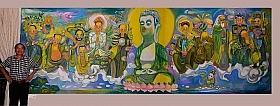
(Painter Dai Giang next big wall paintings)
These paintings contain gentle, harmonious colors and are strongly influenced by Vietnamese folk art. However, there are also dark shades opposing each other to express ignorance and enlightenment.
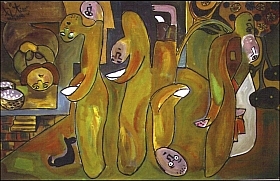
(Alms)
In the murals depicting the Four Noble Truths, the first mural depicts suffering with the images of Birth, Aging, Disease, and Death. The second one, which is about the cause of suffering, concretizes the concepts of greed, illusion and ignorance in the Six Realms of reincarnation: Hell, Hungry Ghosts, Animal, Asura, Man, and God. The third mural depicts the Western Paradise of Amitabha Buddha. The fourth mural depicts the Noble Eightfold Path, the path to liberation, with various practices from ascetics to enjoyment. The fifth mural depicts the harsh life of Ms Thi Kinh as a terribly unjust life. But with patience and compassion, Ms.Thi Kinh achieved enlightenment and transformed the people who harmed her. Because of those practices, she has been worshiped by the people as the manifestation of the compassionate Guan Yin Bodhisattva.
“The Mendicants” painting is flooded with colorful colors of the Orient in an effort to harmonize the givers and receivers. The surreal images of the monks mix with people and things around them in a world of joy and peace.
“Shakyamuni Buddha” is with the dominant yellow, the color of liberation. The Buddha’s face is upside-down to direct the eyes looking inward. The
“Amitabha Buddha” with a light brown color depicts the innocent world with the children around Amitabha Buddha under the bodhi tree.
“The Thousand Arms and Thousand Eyes Bodhisattva” shows the Avalokitesvara having a thousand eyes in a thousand hands. The eye symbolizes understanding and the arm symbolizes compassion.
“The Avalokitesvara’ sitting under a tree with a reflecting face on the ground symbolizes looking inwardly at the Buddha nature.
Zen Master Vu Khac Minh painting in gray and black, depicts the ascetic effort to overcome the humblest of human beings to reach the higher realm of liberation.
The Dalai Lama’s portrait depicts the compassion of the spiritual leader of the Tibetan people, and he is also the leader of the Buddhist world.
Zen Master Thich Nhat Hanh painting with his bright eyes expresses the transcendental wisdom of a modern teacher.
“Monk Thich Tri Hoang” was looking at a skull to contemplate on the impermanence of life.
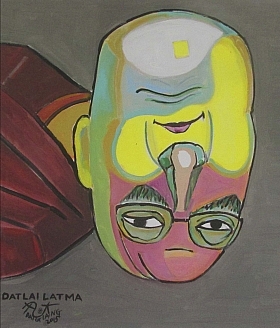
( Dalai Lama)
Style and Color:
The style and color of DaiGiang Nguyen paintings are strongly influenced by the folk art of Dong Ho village, Vietnam. The painter combines modern and traditional art between the East and the West.
In particular, the upsidedownism illustrates ingenious contradictions of life. This drawing opened up a new dimension. That is the spiritual dimension. In the paintings of the Sakyamuni Buddha, the artist brought his eyes down to look inwardly. In the painting Western Paradise with upsidedown bodhisattva figures he depicts the concept of ten directions in Buddhism. In the paintings of His Holiness the Dalai Lama and Zen Master Thich Nhat Hanh, the upsidedown faces express the meaning of cultivating the monk’s life as going against the current of life, transcending the normal life in order to reach the higher horizons.
Buddhist thought:
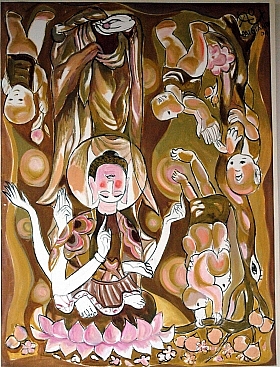
( Buddha Amitabha Buddha)
The No Self and Impermanence Philosophy of Buddhism have strongly influenced the paintings of DaiGiang Nguyen
The concept of selflessness advocates that there is no permanent self, not attached to a fixed form. From this philosophy, the artist was free to reverse the order of the human body as well as things. The eye does not need to be at the top and the mouth does not need to be at the bottom. The head does not need to be on the neck, and the limbs are not necessarily in the fixed position. This freedom has opened up a new horizon for the artist to express the depth of inner life and the spiritual dimension.
The impermanence philosophy holds that things are constantly changing: conflicting conditions are present at the same time in all things. Happiness is present in the suffering: in suffering there is the seed of happiness. The painter put this philosophy into his paintings in order to describe the contradictions of life.
Painter Dai Giang Nguyen used paintings to describe the deeply philosophical ideas of Buddhism about suffering in human life and the liberation from that suffering. The painter broke the stereotypes inherent in painting to achieve absolute freedom in expressing the spiritual dimension. DaiGiang Nguyen is the founder of the upsidedownism school to see people and things in a new dimension.
Phap Nguyen Temple, Texas, July 20, 2017
Rev. Thich Tri Hoang